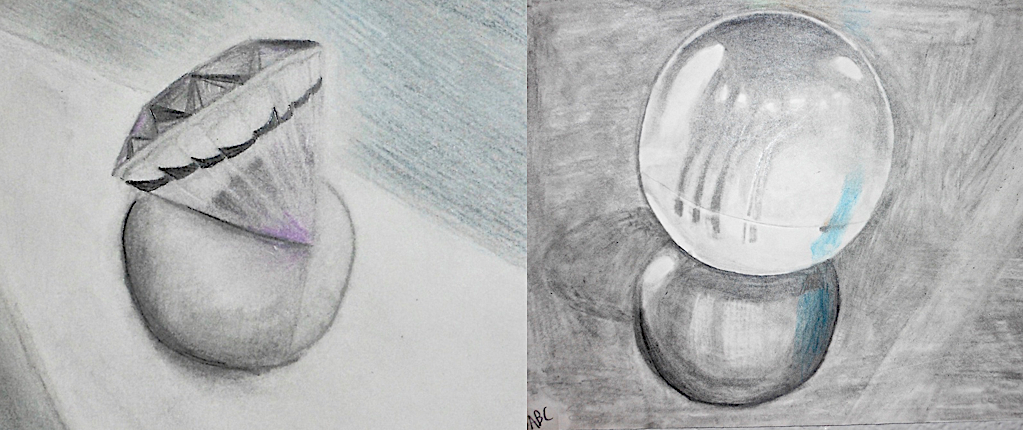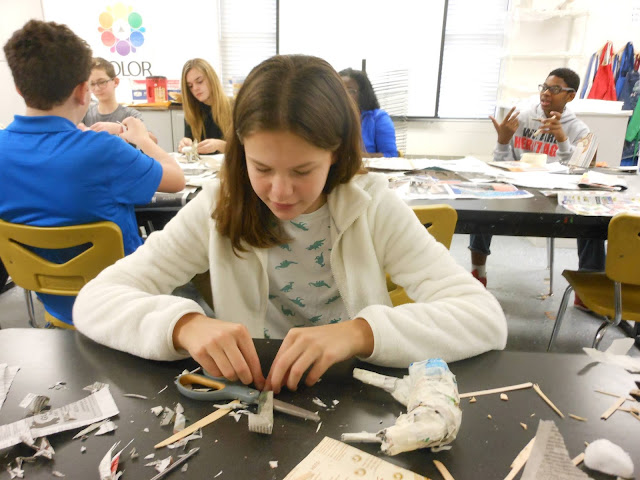February 2020
High school Art I students have been working hard on zoomorphic vessels; containers made in the shape of an animal! We looked at Pre-Columbian ceramic designs first, then brainstormed ways to incorporate an animal we admired into our sculpture. Building with clay is a challenge - it is a soft medium which requires a lot of patience! I am very proud of the work our students did! They learned several different clay techniques throughout the process: coil building, slab building, and proper attachment of the pieces.
 |
| Bald eagle design by A.B.C. |
 |
| Puffer Fish design by Chris |
December 2019
Paper mache sculptures are in progress! High school students thought about scriptures that God has been using to minister to them, then brainstormed images that would help communicate the meaning of these scriptures. We see a deer emerging that represents Psalm 42:1, a tree that represents the strength that God shares with us, a lion and a lamb, and also a Bible with the sun and the moon that represents God's eternal Word.
 |
| Here are our sculptures, ready to paint! We will learn about surface decoration in January, including how to use spray paint safely. |
September 2019
 |
| by Mackie, grade 10 |
Below are some photos of our drawings and paintings.
 |
| by Andreah, grade 10 |
 |
| by Kaleb, grade 9 |
 |
| by Madison, grade 9 |
 |
| by Chris, grade 9 |
 |
| by ABC, grade 9 |
 |
| by Emily, grade 10 |
 |
| abstract landscapes by Mackie and Emily, grade 10 |
 |
| abstract landscapes by J.C., grade 11 and Michael, grade 9 |
 |
| character abstractions by Kaleb, Chris, and Madison, grade 9 |
 |
| abstract landscape by ABC, grade 9 |
 |
| ABC, grade 9, and Andreah, grade 10, chose a "jewel" and marble to draw in detail. |
September 17, 2019
High school beginning art students practiced their drawing skills this week. We first looked at simple geometric forms, observing the way they take up space. Students practiced drawing a still-life of geometric forms and then shading them to create the illusion of 3-dimensions. We learned to use many values in the shaded areas, including black in the deepest core shadows and white highlights where light reflects off of a surface. Students carefully shaded a sphere in their sketchbooks, using blending tools and drawing pencils, and then used these new skills to draw and shade a still-life of their choice.
We applied the Principles of Design in these still-life arrangements, thinking about a focal point, contrast, movement, balance, repetition, and variety. Even though realistic shading was the goal, the last day of the project we added a bit of creative flair!
 |
| Chris, grade 9, and Kai, grade 9 |
 |
| Michael, grade 9, J.C., grade11 |
 |
| Madison, grade 9, Emily, grade 10 |
September 7, 2019
During the first month of school we have had *10 classes in Art I, and students have been working hard to create an original autobiographical mixed-media art piece entitled, "The Box." We learned about the Elements and Principles of Design, the basic language of art, and how to organize our artwork according to these "rules" of design. We also talked about I Corinthians 12:12-31 in relation to this assignment; all of us are amazing masterpieces in the hands of God, created for His good purpose. We are all different, so let's celebrate each other and our unique gifts!
 |
| "Art I" high school students work on covering their boxes with an assortment of materials |
Students first brainstormed personality traits and then searched for related images, colors, textures, etc. that could serve to communicate aspects of their personality. How could they "say" something about themselves and their lives through art? This was a challenge!
Students decided on a dominant color and shape for their projects and began thinking about unifying the design by repeating the same colors and shapes. They collected a variety of patterns, textures, or values of the same color and began cutting up their collection of materials into the same types of shapes. In addition, students chose an image to serve as the main focal point of the piece, or "Emphasis." They were tasked with repeating the related elements all over the entire box, paying careful attention to craftsmanship and neatness. Students used magazine images, wallpaper scraps, paint, and even Legos. These are wonderful expressions of unique personalities!
To end this unit of study, Art I students looked at the work of three famous 20th century artists who used the medium of collage: Pablo Picasso, Henri Matisse, and Romare Bearden. They also practiced using this new vocabulary of the Elements and Principles of Design to analyze art through discussions and written assignments, one of which was an informal peer critique. Students will continue applying the Elements and Principles of Design to their artwork throughout the entire year.
Resources for *Weeks 1-4:
Embrace the Shake, Phil Hansen, TED Talk
Your Creative Bank Account, Jake Parker, YouTube
Romare Bearden: Visual Jazz, DVD
Henri Matisse, collage artist
Khan Academy: Still Life With Chair Caning by Picasso
*Students meet for Art class three times each week; Monday, Tuesday, and Thursday. We did not meet on two Mondays and one Thursday, which resulted in our art classes adding up to a total of 10 sessions for the first four weeks of school.
 |
| by Kai and Chris, grade 9 |
 |
| by Madison, Michael, and ABC, grade 9 |
 |
| by Emily and Andreah, grade 10 |
I Corinthians 12:12-31
For as the body is one and has many members, but all the members of that one body, being many, are one body, so also is Christ. For by one Spirit we were all baptized into one body—whether Jews or Greeks, whether slaves or free—and have all been made to drink into one Spirit. For in fact the body is not one member but many.If the foot should say, “Because I am not a hand, I am not of the body,” is it therefore not of the body? And if the ear should say, “Because I am not an eye, I am not of the body,” is it therefore not of the body? If the whole body were an eye, where would be the hearing? If the whole were hearing, where would be the smelling? But now God has set the members, each one of them, in the body just as He pleased. And if they were all one member, where would the body be?But now indeed there are many members, yet one body. And the eye cannot say to the hand, “I have no need of you”; nor again the head to the feet, “I have no need of you.” No, much rather, those members of the body which seem to be weaker are necessary. And those members of the body which we think to be less honorable, on these we bestow greater honor; and our unpresentable parts have greater modesty, but our presentable parts have no need. But God composed the body, having given greater honor to that part which lacks it, that there should be no schism in the body, but that the members should have the same care for one another. And if one member suffers, all the members suffer with it; or if one member is honored, all the members rejoice with it.Now you are the body of Christ, and members individually. And God has appointed these in the church: first apostles, second prophets, third teachers, after that miracles, then gifts of healings, helps, administrations, varieties of tongues. Are all apostles? Are all prophets? Are all teachers? Are all workers of miracles? Do all have gifts of healings? Do all speak with tongues? Do all interpret?But earnestly desire the best gifts. And yet I show you a more excellent way.
Alabama Course of Study Standards for High School Art "Novice Level" (formerly known as Art I)
Investigate, Plan, Make
1. Explore multiple approaches to begin the creative process. Examples: brainstorming, word association, thumbnail sketches, preliminary drawing
2. Utilize the elements and principles of art/design in an artistic investigation of present-day life using traditional and/or contemporary practices.
6. Apply relevant criteria from traditional and contemporary cultural contexts in a reflective artist statement
12. Describe the effectiveness of expressive and meaningful communication in selected works of art.
a. Analyze the formal organization of subject matter, elements of art, and principles of design in determining structural relationships in selected works of art.
13. Expand the use of art-specific vocabulary to describe and define techniques and materials used to evaluate art.
a. Define visual art terminology, including the elements of art and principles of design.










No comments:
Post a Comment
Note: Only a member of this blog may post a comment.